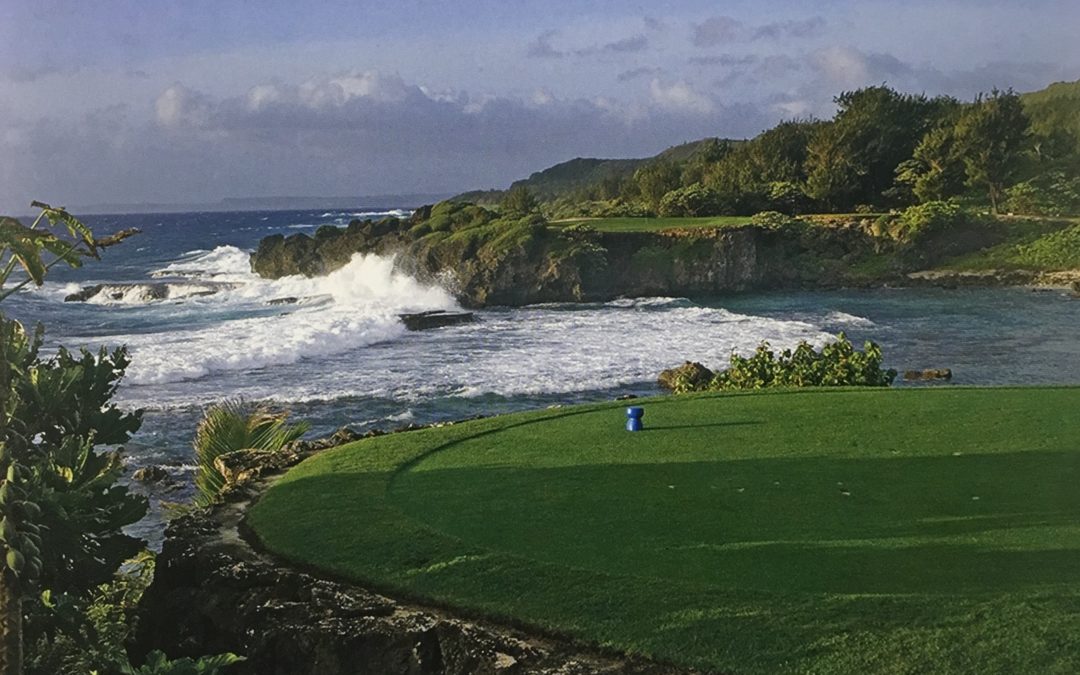Mill Valley, California’s Robin Nelson, of Nelson & Haworth, Golf Course Architects, designed Mauna Lani Golf Courses on the Kohala Coast, in Hawaii; Bali Golf and Country Club in Nusa Dua, Bali; Ravenwood Golf Club in Victor, New York; The  Dragon at Gold Mountain in Portola, California; and Shenzhen Golf Club in Shenzhen, China. A graduate of the University of California, Berkeley, Nelson earned his AB in landscape architecture.
Dragon at Gold Mountain in Portola, California; and Shenzhen Golf Club in Shenzhen, China. A graduate of the University of California, Berkeley, Nelson earned his AB in landscape architecture.
We were asked to design a new eighteen-hole golf course, Mangilao Golf Course, on the island of Guam in early 1990. Guam’s location in the middle of the Pacific Ocean exposes it to some of the most extreme weather on our planet, including super typhoons, with winds over two hundred miles per hour, along with numerous category three and four hurricanes.
Guam is also home to one of the greatest ocean Par-threes in the world: the twelfth at Mangilao, which measured 188 yards from the tips and 99 yards from the forward tees. Its beauty is surpassed only by its story.
The peninsula upon which the twelfth green rests was very difficult to discover, even with the best topographic maps. The terrain was so rough that even crawling though the vegetation was impossible. It was only after helicopter reconnaissance that we found it, but once the hole was identified, the rest of the course was designed around it.
Getting permits from the Environmental Protection Agency in Washington, DC proved to be quite difficult, as the regulatory body needed to inspect the green area because it was within the shoreline setback zone. That meant we had to place a ribbon around its entirety, which, in turn, meant I had to swim over to the rock and do my best climb its twenty-five-foot-high sheer face.
We then had an approximate six- to nine-month period for the permit to take effect. Super Typhoon Russ was on our side in this instance though. Two weeks after placing the ribbon, the storm showed its fury and removed all the vegetation for us! Presto – no vegetation: no permit needed!
So we were on our way.
The green was built and grassed. However, during grow-in later that year, Super Typhoon Yuri hit and wiped out everything, including cart paths, irrigation lines, trees, and concrete thrust blocks. This storm was well forecast and everyone decided to witness it this time. One of the shapers was caught on the green when a hundred-foot wave hit and almost washed him out to sea. Luckily he wasn’t killed.
The decision was made to rebuild the green, knowing that these storms could hit every ten years or so. The green’s infrastructure was rebuilt in reinforced concrete, and a par-three, nineteenth hole was built out of harm’s way so that its sod could easily be used to rebuild the twelfth green quickly.
Less than one year after that, Typhoon Omar hit and totally destroyed the green, but because of the planning, the concrete infrastructure, and the nineteenth hole, we were able to get the green back into place and playable in three weeks.
Typhoon Paka unofficially recorded sustained winds of over 225 miles per hour, which is still being debated to this day as possibly the strongest winds ever recorded on the planet. But due to creative structural solutions and lifestyle of the maintenance staff and superintendent Ken Gokey, who take these massive storms as facts of life, the twelfth hole at Mangilao will live on, and continues to be one of the most beautiful par three holes in the world.

